German Weapons during WW2 (Rifles, Guns, Mines, Vehicles)
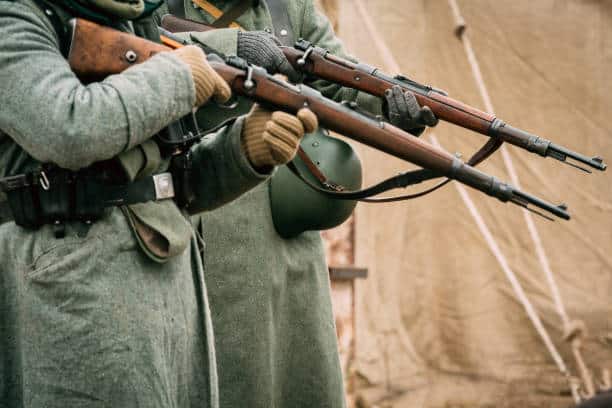
During World War II, German infantrymen were equipped with a variety of weapons, each designed to fulfill specific roles on the battlefield. This page provides a detailed look at the rifles and other weapons used by German forces.
German WW2 Rifles
The standard German infantry weapon was the rifle, originally designed by Mauser, and dubbed the Karabiner 98k. This weapon was a 5-shot, bolt-action rifle that actually dated back to 1898 when it was first adopted by the Imperial German Army.
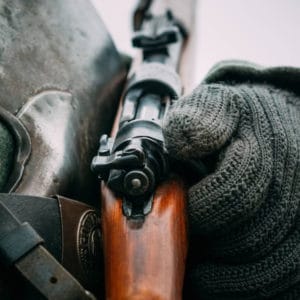
It was a standard-issue for German troops in WWI and, in its modified 98k version (k for Kurz, or short), in WWII as well.
While the German standard rifle was a bolt action rifle, the Germans did attempt to design a successful automatic rifle as well. Two designs were submitted for trials in 1941, one by Walther (the maker of the famous PPK and the P38 pistols), and the other was submitted by Mauser.
The Mauser design won out over the simpler Walther design and many thousands of the Gewehr 41(W) were made available to the troops on the Eastern Front. After initial use, results were less than satisfactory and as soon as a better design came along, production was halted.
The way in which German troops used their weapons changed and a rifle with a range of 2000 yards was no longer needed – except for specialists and snipers. Instead, ranges had shrunk down to 400 yards and a less powerful cartridge was needed.
Karabiner 98k
- Type: Bolt-action rifle
- Caliber: 7.92×57mm Mauser
- Effective Range: 500 meters
- Magazine Capacity: 5 rounds
Gewehr 43
As the war progressed, semi-automatic rifles became more common. These weapons used gas operation, allowing soldiers to fire shot after shot without manually cycling the bolt.
- Type: Semi-automatic rifle
- Caliber: 7.92×57mm Mauser
- Effective Range: 500 meters
- Magazine Capacity: 10 rounds
- Notable Feature: Gas-operated mechanism for faster firing
German WW2 Handguns
Handguns were typically issued to officers, pilots, and tank crew for close combat situations.
Walther P38 and Luger P08
- Caliber: 9×19mm Parabellum
- Notable: The Luger P08 was highly prized as a trophy by Allied soldiers
German WW2 Submachine Guns
The most common submachine gun used by the Germans during WWII was the MP40. Many times the term “Schmeisser” is used in reference to a German submachine gun. While it is true that the Schmeisser firm did create and produce its own submachine gun design, it was less than perfect and prone to trouble.
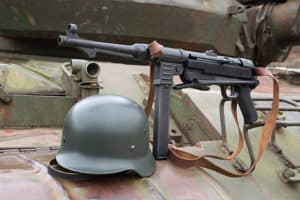
The MP40 was not manufactured by Schmeisser, and the weapon was far more simple and had a much cleaner design, thus it became the standard issue for German troops.
An earlier design called MP38 had a similar appearance and saw widespread distribution. A less known model called Erma was also produced as well as a German copy of the British STEN gun, called MP3008.
The Waffen-SS used a submachine gun made by Bergman called the MP34 also.
The next submachine gun design to emerge was the MP43 or Machine Pistol 43 from a design developed in 1943. It fired a less powerful cartridge and had a lighter recoil as a result.
However, Hitler, still thinking that troops needed a weapon capable of firing 2000 yards, ordered that production of the weapon not start. The German arms minister, however, knew the need for the new weapon and changed the name to “Machine Pistol”, which is what the Germans called their submachine guns like the US Thompson .45 cal.
The trick worked and the weapon went into production at three factories. German troops all over the Eastern Front were clamoring for the new weapon.
The whole affair was blown when a few divisional commanders asked Hitler at a conference when they would get the new weapon. Hitler was furious and ordered an investigation.
Luckily for the men that had disobeyed the Führer, the results of the investigation were so encouraging about the new weapon that Hitler changed his mind and announced that henceforward the weapon would be called “Sturmgewehr” or Assault Rifle.
The Maschinen Pistole 43’s origin was actually the Maschinen Karabiner 42 (MKb 42). It looked a lot similar and was issued in numbers on the eastern front.
Later, this weapon was refined into the MP43. The Germans, contemplating the sniping value of the MP43, made a variant, called the MP43/1. It had scope mounting rails on the iron-sights. The sniper arrangement didn’t really work, so, few were made.
In late 1943, the MP44 (the most commonly found German assault rifle from the war) was developed, though being basically the same thing as its predecessor.
In 1945, Mauser had begun work on a new type of assault rifle (sometimes called the StG45(M), sometimes the Gerat O6), that used a roller-locking mechanism (like that of the MP5), which slowed the ROF down to 450 RPS. However, these rifles never made it past the prototype phase.
MP-40
- Type: Submachine gun
- Caliber: 9×19mm Parabellum
- Effective Range: 100-200 meters
- Magazine Capacity: 32 rounds
- Users: Infantrymen, paratroopers, platoon and squad leaders
StG-44 (MP-44)
- Type: Assault rifle
- Caliber: 7.92×33mm Kurz
- Effective Range: 300 meters
- Magazine Capacity: 30 rounds
- Significance: Inspired post-war designs like the AK-47
German WW2 Light Machine Guns
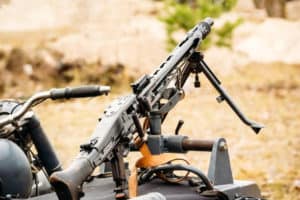
The Germans settled on two light machine gun designs and used them throughout the war, the MG34 and MG42.
The MG42 went on to become the standard design for a light machine gun for NATO and is now used in a more modern form by the US military as the M-60! The new German Army continues to use a less modified but still modernized version of the MG42 as their standard light machine gun.
MG-42
- Type: General-purpose machine gun
- Caliber: 7.92×57mm Mauser
- Rate of Fire: 1200-1500 rounds per minute
- Magazine Capacity: Belt-fed
- Nickname: “Hitler’s Buzzsaw” due to its high rate of fire
Other German WW2 Infantry Weapons
German infantrymen were also equipped with a range of other weapons:
Flamethrowers
- Usage: Intimidating weapon used to clear enemy positions, especially in the Pacific theater.
Grenades
- Types: Explosive, smoke, and tear gas grenades were standard issue. The Molotov cocktail, although more primitive, was also used effectively.
German WW2 Mines
The Germans used an assortment of mines. One is referred to as a “pot mine”. An acid would ignite the primer when the vile it was in was crushed and the primer would explode the main charge. This was an anti-personnel mine.
Another mine was the “S-Mine” or “shrapnel-mine”. It was buried with a couple of trigger wires sticking out of the ground, and when tripped, it would launch into the air and explode showering the area with high-velocity steel balls. The S-Mine was used as an anti-personnel mine also.
The standard anti-tank mine in use was called the “Tellermine” and contained one pound of TNT. It was a large flattened circular plate-shaped mine with a carrying handle on one side. The Tellermine had a pull ignitor for special use, or more commonly, the centrally mounted detonator charge was screwed into the base charge. It took 350 pounds to set off this mine and it could rip the tracks off any tank.
The German “Holzmine” or “wooden mine” was an attempt to defeat the Allied metal detecting mine detectors. It was a wooden box with ten pounds of TNT inside with a detonator that took 250 pounds of pressure to ignite. This mine was also an anti-tank mine.
Another mine was the Riegel Mine 43. It was a long narrow rectangle filled with 8.8 pounds of Amatol explosive. It had several means of detonation – by applying 880 pounds of pressure to the center, or 440 pounds to the ends, or by one of the three ignitors wired together(one on top, two on the side) as a booby trap, or the sheer wires near the ends that freed the ignitors inside when the proper amount of pressure was applied to the ends.
One of the most ingenious mines used was the German Army “Goliath” remote-controlled mine. It was a small tracked vehicle, controlled via wire by a driver and steered to its objective. It was driven by a small electric or petrol motor and carried 166 pounds of TNT.
WW2 Soviet Weapons Captured by Germans
During the invasion of Russia, the Germans captured thousands of Soviet 76.2mm field pieces. The Germans had the weapon bored out to accept a heavier charge and the weapon became an effective German anti-tank weapon.
After the war, the Russians used these weapons as the basis of many of their post-war designs. The weapon was referred to as the Infantrie Kanone 290(r) where the “r” indicated “Russian”. The weapons were referred to as a 75mm by the Germans even though it was actually a 76.2mm. The Germans liked the weapon so much that they manufactured their own ammunition for the gun after stocks of captured Russian ammunition were used up.
German WW2 Anti-tank Guns
German PAK or anti-tank gun design changed with the demands of war. The standard infantry anti-tank weapon was the PAK38 – a 50mm AT gun roughly equivalent to the British 6 pounder AT gun. It was used throughout the war by the Germans.
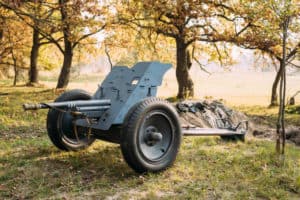
The PAK40 was Rheinmettal’s scaled-up version of the PAK38 and was a 75mm AT weapon produced in 1940.
The KruppPAK41 was the answer to the demand for even heavier weapons in the anti-tank role. It used a brilliant design of a tapered barrel that went from 75mm at the breech to 55mm at the muzzle. Its overwhelming performance allowed it to defeat any tank in the world. Unfortunately, the shortage of tungsten, needed for the special shot, shortened its life.
The German PAK44K prototypes were ready before the gun carriages were built so they were mounted on captured French 155mm GFP-T carriages. The increased recoil of the heavier gun prevented the combination from being particularly successful.
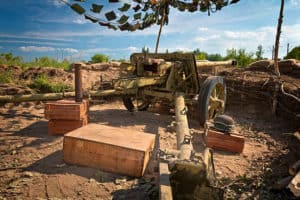
The German SPzB41 used the Gerlich taper-bore principle. It was first used by the Germans in the Western Desert. When a captured specimen was tested the performance was so impressive that the British sped up the development of their own squeeze principle.
The PAK44K Krupp 128mm At gun promised to be one of the finest anti-tank guns ever built following the principle the best way to deal with tanks is to hit them hard and at as long a range as possible. However, the war ended before it could be put into production.
Another design called PAW600 used a high-low pressure system, by which the 80mm projectile separated from the charge by a perforated plate. The pressure from the explosion was fed more slowly into the barrel so that the barrel need not be so heavy and the gun is more manageable. Its career was cut short by the end of the war. While the PAW designation marks this weapon as are recoilless rifle weapon its design was that of a standard artillery field piece.
The PAWs (Panzerabwehrwerfer) or recoilless anti-tank rifles, were unveiled in the invasion of Crete by the German Luftwaffe paratroops that needed a lightweight gun that could be carried in pieces and when needed, assembled for use. The first 75mm model was so successful that a 105mm model was put into production and used against the British on Crete.
Panzerschreck
- Type: Portable anti-tank rocket launcher
- Caliber: 88mm
- Usage: Effective against armored vehicles
German WW2 Rail Guns
The Germans also had an assortment of rail guns, huge artillery pieces mounted on railroad cars, and self-propelled mortars that crawled about on huge tracked carriages.
One such mortar or “Mörser” was the 600mm “Karl” battery. It weighed 132 tons, was 35 feet long, and moved at 3 mph by a 580hp diesel engine. It had a ground crew of 109 men and it could fire a 4,850-pound mortar round that could penetrate 98inches of concrete or 17-3/4″ of armor.
The railguns were even larger yet, the 800mm Kanone “DORA” had a range of 29 miles, a crew of 250 men for assembly and firing, and 4,120 men in all. It could fire one 10,500 pound shell that measured 25 feet long plus the length of the case at a rate of 2 rounds per hour.
The 280mm KS(E) rail gun was 95 feet long, weighed 479,600 pounds. and could fire a projectile 38 miles. It used a crew of 10 for firing.
German WW2 Howitzers
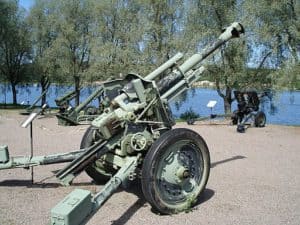
The Germans also fielded a wide assortment of howitzers. The 105mm Leichte Feldhaubitze 18M L/28 or 105mm light field howitzer fired at a rate of 6-8rounds per minute up to a range of 13,377 yards and was manned by a crew of 6. The 105mm Leichte Feldhaubitze 43 L/28 had a range of 17,875 yards at a rate of6 rounds per minute with a crew of 6.
One of the most widely used field pieces by the Germans was the six-barreled rocket launcher called the “Nebelwerfer”. The weapon fired a heavy projectile from a light carriage. The tubes had to be fired one at a time taking 10 seconds to complete to keep the weapon from overturning. It wasn’t very accurate, but could be reloaded in 90 seconds and was very maneuverable. It had a range of 7,330 yards with high explosives and 7,750 yards with smoke shells. The rockets weighed 75.3 pounds for HE and 78 pounds for smoke.
German WW2 Anti-aircraft Weapons
The true German trump card was the feared and respected 88mm FLAK. Its high-velocity gun made it an anti-tank threat that could defeat almost any tank armor in the world. Its accuracy also made it a deadly anti-aircraft weapon. The same weapon could serve in both modes without any modifications to the carriage or mount.
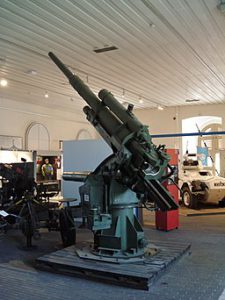
The 88mm FLAK was 25 feet long overall, had a rate of fire of 8 rounds per minute, a crew of 6, and had a maximum effective altitude of 14,680 meters and a horizontal range of 10,600 meters. The development of the 88mm FLAK weapon was the 105mm FLAK and was mostly used as an AA weapon against Allied aircraft. I had a crew of 5 and a rate of fire of 3 rounds per minute. Its maximum ceiling was 12,800meters.
A somewhat smaller weapon was the Flakvierling or quad-mounted 20mm AA weapon that was on a lightweight towed carriage. Other versions were mounted on tank chassis, one version was called the Wirbelwind or whirlwind and was enclosed by an open-top turret and mounted on a Pzkw IV chassis.
Another Flakvierling termed the Ostwind has mounted on a tank chassis also but had huge armor plates that dropped down to reveal the gun. Others were mounted on the half-tracked Sdkfz 250/251s widely used by the German forces. Larger weapons were also mounted on these half-tracks like the single mount 37mm Flak 43 which had a rate of fire of 150 rounds per minute versus the 700/800 rounds per minute of the quad mounted weapons.
Another 88mm AA weapon was created by the marriage of the Porsche designed Pzkw VI “Tiger” chassis that failed in the competition against the winning Henschel design for the production contract and the 88mm FlaK. This combination was called the “Cricket” or “Grille”.
German WW2 Armored Vehicles
German armored vehicles like the Sud Kampffahrzeug or SdKfz were commonplace. The German variant of the US Whiting M3 half-track was the SdKfz 250 and 251. the difference is the overall size of the vehicle in the two models. These served as infantry carriers in the forward areas for the Panzergrenadier to ride in so they could keep up with fast-moving armor.
The Germans also developed a half-track lorry or a cargo truck called the Maultier or Mule which was built mainly by Opel and based on the Opel Blitz 3 ton military truck, except the rear wheels were replaced by a pair of tracks.
With the rising caliber and size of field artillery and anti-tank guns, the weight of the weapons increased as well. A tracked prime mover was designed and produced as the SdKfz 7. This vehicle was a huge 8 ton tracked truck. The tracks would run nearly the length of the vehicle and top a few feet short of the front wheels.
It had three large bench style seats and a large cargo area behind the last row of seats. The SdKfz 7 was used to pull the larger artillery and AT weapons like the FlaK 88. It was manned by two men and could carry 9 more men as well as all the stores and the towed weapon.
German reconnaissance vehicles were armored as well and the SdKfz 222 was a small light recon vehicle with 4 wheels and a 20 mm gun in a top turret.
The SdKfz 231 Puma was a heavy recon vehicle. It had 8 wheels and all-wheel steering. There were driver positions in the front and the rear of the vehicle in case an escape was necessary and turning around wasn’t possible. Its main weapon was a 20mm gun in a top-mounted turret.
The SdKfw 231 was a wheeled version of the SdKfz 251 chassis. The 231 model had three axles with 10 tires and the 232 model was a 4 wheel version.
German WW2 Motorcycles
The Germans also used motorcycles extensively for liaison and reconnaissance purposes. BMW, NSU, DKW, and Zundapp produced motorcycles for the German Army. The BMW R/75 746cc 26hp motorcycle is perhaps the best-known type, however.
All tank divisions had motorcycle infantry units. Two or three motorcycle companies and an HQ company formed a motorcycle battalion.
An average infantry division on the Eastern Front in the early stage of the war used 452 motorcycles including those with a sidecar, made up as follows:
- 17 (HQ co.),
- 45 (recon unit),
- 32(signal battalion),
- 141 (infantry regiment),
- 40 (artillery regiment),
- 45(anti-tank gun battalion),
- 44 (engineer battalion),
- and 88 (supply unit).
The average infantry division in 1943 to 1944 came to use an increasing number of Kubelwagens and Kettenkrads which had excellent durability and various uses in place of motorcycles. Thus, the number of motorcycles was reduced to 168.
The German Army originally grouped motorcycles into 3 classes: small class under 350cc, middle-class 350cc-500cc, and large class over 500cc.
Most early models of German military motorcycles proved unreliable after the invasion of Russia and only the BMW R/75 was rugged enough to do the job. Its reliability was such that after the war the Russian Army used faithful copies of the BMW R/75 called the K-M72.
German WW2 Utility Vehicles
Mercedes, Opel, and Bussing-NAG were the prime suppliers of 3-ton trucks used by the armed forces as infantry carriers and cargo/ supply purposes, and Volkswagen supplied the German forces with their version of a small utility vehicle like the American Jeep.
The German vehicle drew heavily on the commercial vehicle that was introduced to the public in 1933 as the People’s Car or Volkswagen. The military version of this vehicle was called Kubelwagen, a comment on its appearance because the vehicle reminded the Germans of a tub with wheels (Kubel meaning tub, bucket, or pail).
The vehicle was a simplified Volkswagen Beetle with square lines and a rear engine drive. It had the common canvas top of most military vehicles and could carry 4 passengers.
Another version was designed and called the Schwimmwagen which stood for an amphibious car since it was designed to float across rivers. Its appearance differed slightly with more rounded lines and a propeller mounted in the rear behind the engine that the driver could engage once in the water.
